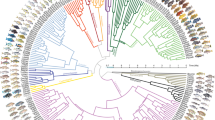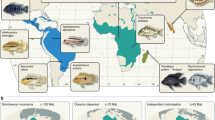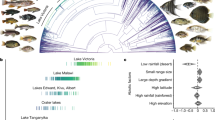Abstract
SINCE their discovery at the turn of the century1, the species assemblages of cichlid fishes in the East African Lakes Victoria, Malawi and Tanganyika have fascinated evolutionary biologists. Many models have attempted to account for the 'explosive' evolution of several hundred species within these lakes2–7. Here we report a case of surprisingly large genetic divergence among populations of the endemic Tropheus lineage of Lake Tanganyika. This lineage of six species contains twice as much genetic variation as the entire morphologically highly diverse cichlid assemblage of Lake Malawi and six times more variation than the Lake Victoria species flock. Although it is highly variable in coloration, this group of species and its closest relatives have not undergone appreciable morphological change. The observed geographic pattern of genetic variation suggests that major lake level fluctuations affected the distribution and speciation of this lineage of cichlid fishes.
This is a preview of subscription content, access via your institution
Access options
Subscribe to this journal
Receive 51 print issues and online access
$199.00 per year
only $3.90 per issue
Buy this article
- Purchase on Springer Link
- Instant access to full article PDF
Prices may be subject to local taxes which are calculated during checkout
Similar content being viewed by others
References
Boulenger, C. L. Trans. Zool. Soc. Lond. 15, 1–30 (1898).
Avise, J. C. Nature 347, 512–513 (1990).
Kosswig, C. Nature 159, 604–605 (1947).
Fryer, G. & Iles, T. D. The Cichlid Fishes of the Great Lakes of Africa (Oliver & Boyd, Edinburgh, 1972).
Mayr, E. in Evolution of Fish Species Flocks (eds Echelle, A. A. & Kornfield, I.) 3–11 (University of Maine Press, Orono, 1984).
Dominey, W. J. in Evolution of Fish Species Flocks (eds Echelle, A. A. & Kornfield, I.) 231–249 (University of Maine Press, Orono, 1984).
Meyer, A., Kocher, T. D., Basasibwaki, P. & Wilson, A. C. Nature 347, 550–553 (1990).
Larson, A. in Speciation and its Consequences (eds Otte, D. & Endler, J. A.) 579–598 (Sinauer, Sunderland, Massachusetts, 1989).
Selander, R. K., Yang, S. Y., Lewontin, R. C. & Johnson, W. E. Evolution 24, 402–414 (1970).
Poll, M. Ac. Roy. de Belg. Memories de la classe des sciences. Collection in 8°-2e série, T.XLV. Fasc. 2, 1–16 (1986).
Nishida, M. Experientia 47, 974–979 (1991).
Greenwood, P. H. in Evolution of Fish Species Flocks (eds Echelle, A. A. & Kornfield, I.) 141–154 (University of Maine Press, Orono, 1984).
Brichard, P. Cichlids of Lake Tanganyika, (TFH Publications Inc., Neptune City, New Jersey, 1989).
Sturmbauer, C. thesis, Univ. Innsbruck, Austria (1990).
Brown, W. M., Prager, E. M., Wang, A. & Wilson, A. C. J. molec. Evol. 18, 225–239 (1982).
Tiercelin, J.-J., Mondeguer, A. in Lake Tanganyika and its Life (ed. Coulter, G. W.) 7–48 (Oxford Univ. Press, London, 1991).
Scholz, C. A. & Rosendahl, B. R. Am. Assoc. Petrol. Geol: Memoir 50, 151–168 (1990).
Marlier, G. Rev. Zool. Bot Afr. 59, 164–183 (1959).
Charlesworth, B., Lande, R. & Slatkin, M. Evolution 36, 474–498 (1982).
Charlesworth, B. & Lande, R. Nature 296, 610–611 (1982).
Turner, J. R. in Patterns and Processes in the History of Life (eds Raup, D. M. & Jablonski, D.) 183–207 (Springer, Heidelberg, 1986).
Nelissen, M. Rev. Zool. Afr. 90, 17–29 (1976).
West-Eberhard, M. J. Q. Rev. Biol. 58, 155–183 (1983).
Coyne, J. A. Nature 355, 511–515 (1992).
Owen, R. B. et al. Proc. R. Soc. B 240, 519–553 (1990).
Kocher, T. D. et al. Proc. natn. Acad. Sci. U.S.A. 86, 6196–6200 (1989).
Gasse, F., Ledee, V., Massault, M. & Fontes, J. C. Nature 342, 57–59 (1989).
Kornfield, I. in Cichlid Fishes: Behavior, Ecology and Evolution (ed. Keeleyside, M. H. A.) 103–128 (Chapman & Hall, London, 1991).
Swofford, D. L. Phylogenetic Analysis Using Parsimony, Version 3.0r (Illinois Natural History Survey, Champaign, 1991).
Saitou, N. & Nei, M. Molec. Biol. Evol. 4, 406–425 (1987).
Author information
Authors and Affiliations
Rights and permissions
About this article
Cite this article
Sturmbauer , C., Meyer, A. Genetic divergence, speciation and morphological stasis in a lineage of African cichlid fishes. Nature 358, 578–581 (1992). https://doi.org/10.1038/358578a0
Received:
Accepted:
Issue Date:
DOI: https://doi.org/10.1038/358578a0
This article is cited by
-
East African cichlid fishes
EvoDevo (2023)
-
DNA barcoding the Lake Edward basin: high taxonomic coverage of a tropical freshwater ichthyofauna
Hydrobiologia (2022)
-
Patterns of ectoparasite infection in wild-caught and laboratory-bred cichlid fish, and their hybrids, implicate extrinsic rather than intrinsic causes of species differences in infection
Hydrobiologia (2021)
-
Microevolutionary change in viscerocranial bones under congeneric sympatry in the Lake Tanganyikan cichlid genus Tropheus
Hydrobiologia (2021)
-
Delineating species along shifting shorelines: Tropheus (Teleostei, Cichlidae) from the southern subbasin of Lake Tanganyika
Frontiers in Zoology (2018)
Comments
By submitting a comment you agree to abide by our Terms and Community Guidelines. If you find something abusive or that does not comply with our terms or guidelines please flag it as inappropriate.



